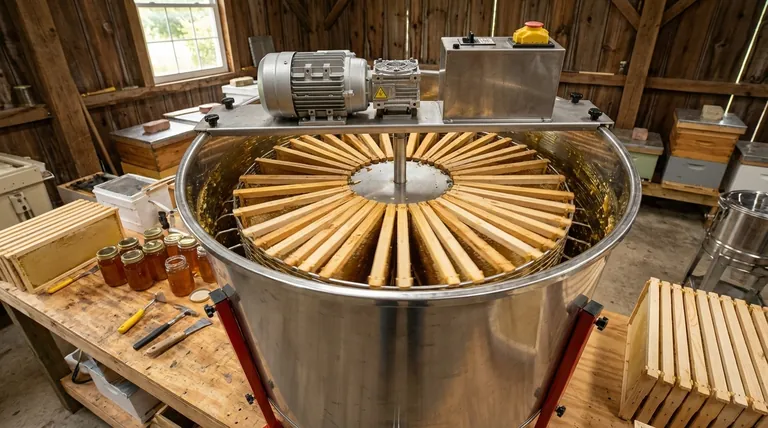At its core, a radial honey extractor is a machine designed for high-efficiency honey harvesting. It works by arranging honey frames like the spokes of a wheel and spinning them, using centrifugal force to pull honey from both sides of the comb simultaneously. This design is preferred by beekeepers with larger operations because it dramatically reduces the time and labor required for extraction.
The decision between a radial extractor and other types is not about which is universally "better," but which tool is appropriate for your scale. Radial extractors prioritize speed and volume, making them ideal for growing or large-scale apiaries.

The Goal of Extraction: Preserving the Comb
Why Use an Extractor?
A honey extractor is a mechanical device that removes honey from the comb without destroying it. This is a fundamental practice in sustainable beekeeping.
By keeping the wax comb intact, beekeepers can return the empty frames to the hive. This saves the bees an immense amount of energy and resources, as they do not have to rebuild the complex wax structure from scratch.
How a Radial Extractor Works
The 'Spokes of a Wheel' Design
A radial extractor positions frames vertically, with the top bar of each frame facing the outer wall of the drum. When the basket spins, centrifugal force pushes the honey straight out from the cells on both sides of the frame at the same time.
The Key Advantage: No-Flip Efficiency
The single greatest benefit of a radial extractor is that you do not have to stop and flip the frames. In other types of extractors, you must spin one side, stop the machine, manually flip every frame, and then spin the second side. The radial design eliminates this entire step, cutting extraction time by nearly half.
Gentle on the Comb
Because the force is applied evenly and perpendicularly to the comb's surface, radial extraction is generally very gentle on the wax. This reduces the risk of "blowouts," where the pressure of heavy honey breaks through the wax foundation.
Understanding the Trade-offs
The Alternative: Tangential Extractors
The most common alternative is the tangential extractor. It holds one or more frames flat against the inner wall of the drum. It extracts one side at a time, requiring the manual flip-and-spin process described earlier.
Tangential extractors are simpler, less expensive, and are perfectly suitable for beekeepers with only a few hives where time is not the primary concern.
Upfront Cost and Scale
The primary trade-off is cost. Radial extractors are more complex and are almost always more expensive than tangential models of a similar frame capacity. Their value is realized through the significant time savings they offer during large extraction jobs.
Manual vs. Motorized
Both radial and tangential extractors come in manual (hand-crank) and motorized versions. For a small radial unit, a hand crank is manageable. However, for any medium-to-large capacity radial extractor, a motor is practically essential to maintain the consistent speed needed for efficient extraction and to save your arms from exhaustion.
Making the Right Choice for Your Apiary
Your decision should be based on a realistic assessment of your beekeeping goals and current scale.
- If your primary focus is a small hobby (1-4 hives): A tangential extractor offers the best value and is more than sufficient for your needs.
- If your primary focus is growth and efficiency (5-15 hives): A small-to-medium radial extractor is a wise investment that will pay for itself in time saved.
- If your primary focus is large-scale production (15+ hives): A large, motorized radial extractor is the professional standard for maximizing throughput.
Choosing the right tool for your specific operation ensures honey harvesting remains a productive and rewarding part of your beekeeping journey.
Summary Table:
| Feature | Radial Extractor | Tangential Extractor |
|---|---|---|
| Extraction Method | Extracts both sides of the frame at once | Extracts one side at a time; frames must be flipped |
| Best For | Medium to large-scale apiaries (5+ hives) | Small-scale, hobbyist beekeepers (1-4 hives) |
| Primary Advantage | High-speed, no-flip efficiency | Lower upfront cost, simplicity |
| Key Consideration | Higher initial investment, often requires a motor | More labor-intensive for larger harvests |
Ready to scale your honey production efficiently? HONESTBEE supplies commercial apiaries and beekeeping equipment distributors with durable, high-performance radial extractors designed for high-volume harvesting. Our wholesale-focused operations ensure you get the professional-grade equipment you need to save time and increase your yield. Contact HONESTBEE today to find the perfect extractor for your operation's scale and goals!
Visual Guide

Related Products
- 24 Frame Honey Extractor Commercial Radial Honey Frame Extraction Machine
- HONESTBEE 72 Frame Industrial Electric Honey Extractor for Beekeeping
- 6 Frame Manual Stainless Steel Honey Extractor Beekeeping Equipment
- 40 Frame Commercial Electric Honey Extractor for Beekeeping
- electric honey extractor honey centrifuge 3 frame honey extractor stainless steel honey frame extractor
People Also Ask
- What is a machine used to remove honey from frames? The Complete Guide to Honey Extractors
- What are the advantages of a radial honey extractor? Maximize Your Harvest Efficiency
- What type of honey extractor is best? Maximize Your Harvest Efficiency with the Right Choice
- Can honey extractors accommodate different frame sizes? A Guide to Choosing the Right Extractor
- What are the advantages of a stainless steel honey extractor? Ensure Honey Purity & Long-Term Value



















